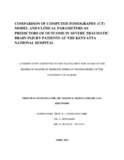| dc.contributor.author | Mohan, Nilesh K | |
| dc.date.accessioned | 2015-09-24T09:07:04Z | |
| dc.date.available | 2015-09-24T09:07:04Z | |
| dc.date.issued | 2015-04 | |
| dc.identifier.uri | http://hdl.handle.net/11295/91434 | |
| dc.description.abstract | Severe traumatic brain injury is associated with a high mortality and morbidity in Kenya. Mortality rates in previous studies in Kenya reported at 51 - 56% in severe TBI patients. Ninety percent of severe TBI worldwide occur in low and middle – income countries. Many of these countries do not have resources for intensive care facilities and there is need to have predictors of outcome in such patients so as to channel resources to patients who are likely to have a better outcome. Use of clinical parameters like the Glasgow coma scale (GCS) is affected by sedation and paralysis of the patients since they are intubated and ventilated on admission. The CT Marshall score has been shown to be a reliable predictor of outcome in severe TBI patients in the western literature but no study done in Kenya to validate it for local data.
The aim of the study was to compare Computed tomography (CT) model by Marshall with other clinical parameters in severe TBI patients like age, GCS with outcome at three months.
Following ethical approval, a prospective study involving eighty six consenting patients above 16 years of age with severe TBI were recruited by random sampling at the Kenyatta National Hospital Accident and Emergency Department and Critical care units over a period of 8 months (May – December 2014) . Clinical parameters of Blood pressure, pupillary reactivity, age, GCS and CT scan Marshall Scoring were evaluated at admission and subsequent follow-up done for 3 month duration for Glasgow outcome scoring. Data was collected and recorded in excel sheets and analysis done using Statistical Package for Social Sciences (SPSS) version 21.0.
In our study of 86 patients, the male to female ratio was 9:1. Overall mortality rate of 52.3%. RTA was the commonest cause of injury at 63.9%, assault 31.1% and falls at 8.9%. Patients with bilateral mydriasis had mortality of 66.7% while patients with anisocoria had 57.5% and | |
| dc.description.abstract | Severe traumatic brain injury is associated with a high mortality and morbidity in Kenya. Mortality rates in previous studies in Kenya reported at 51 - 56% in severe TBI patients. Ninety percent of severe TBI worldwide occur in low and middle – income countries. Many of these countries do not have resources for intensive care facilities and there is need to have predictors of outcome in such patients so as to channel resources to patients who are likely to have a better outcome. Use of clinical parameters like the Glasgow coma scale (GCS) is affected by sedation and paralysis of the patients since they are intubated and ventilated on admission. The CT Marshall score has been shown to be a reliable predictor of outcome in severe TBI patients in the western literature but no study done in Kenya to validate it for local data.
The aim of the study was to compare Computed tomography (CT) model by Marshall with other clinical parameters in severe TBI patients like age, GCS with outcome at three months.
Following ethical approval, a prospective study involving eighty six consenting patients above 16 years of age with severe TBI were recruited by random sampling at the Kenyatta National Hospital Accident and Emergency Department and Critical care units over a period of 8 months (May – December 2014) . Clinical parameters of Blood pressure, pupillary reactivity, age, GCS and CT scan Marshall Scoring were evaluated at admission and subsequent follow-up done for 3 month duration for Glasgow outcome scoring. Data was collected and recorded in excel sheets and analysis done using Statistical Package for Social Sciences (SPSS) version 21.0.
In our study of 86 patients, the male to female ratio was 9:1. Overall mortality rate of 52.3%. RTA was the commonest cause of injury at 63.9%, assault 31.1% and falls at 8.9%. Patients with bilateral mydriasis had mortality of 66.7% while patients with anisocoria had 57.5% and
associated with worse outcome. Patients with GCS of 3 had highest mortality of 85.7% while GCS of 8 lowest mortality of 35.3%. GCS of 3-4 had favourable outcome in only 11.7% at 3 months while GCS of 7-8 had favourable outcome in 52.3%. The CT marshall score of 1 had mortality of 30% while Marshall 3 and 4 at 83.3% and 100% respectively. Patients with tSAH and acute SDH had worse outcomes with mortality of 63% and 57.9% respectively
Severe TBI has high mortality and morbidity in Kenya. In our study, age, the GCS score and the Marshall score were significantly related to the 3 month outcome (p<0.05). GCS score was comparative to Marshall CT on outcome and there was no significant difference between the two parameters in analysis with outcome at 3 months. The CT Marshall score is therefore a reliable predictor of outcome in severe TBI patients. | |
| dc.language.iso | en | en_US |
| dc.publisher | University of Nairobi | en_US |
| dc.title | Comparison of computed tomography (CT) model and clinical parameters as predictors of outcome in severe traumatic brain injury patients at the Kenyatta National Hospital | en_US |
| dc.type | Thesis | en_US |
| dc.description.department | a
Department of Psychiatry, University of Nairobi, ; bDepartment of Mental Health, School of Medicine,
Moi University, Eldoret, Kenya | |
| dc.type.material | en_US | en_US |

